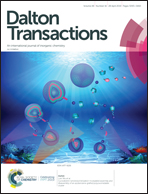Reactive solid phase epitaxy of layered aurivillius-type oxyfluorides Bi2TiO4F2 using polyvinylidene fluoride†
Abstract
Aurivillius-type oxyfluorides are promising ferroelectric and photocatalytic materials. However, their thin films have yet to be fabricated because of the difficulty of synthesis when using both conventional high-temperature gas-phase processes and low-temperature topotactic methods. Here, we present reactive solid phase epitaxy of a layered Aurivillius-type oxyfluoride Bi2TiO4F2 from room-temperature fabricated Bi2TiOx using polyvinylidene fluoride (PVDF) as a fluorine source. Bi2TiO4F2 epitaxial films are obtained by reacting a room-temperature fabricated precursor with PVDF at 330 °C under an Ar flow. However, crystallization does not proceed through PVDF treatment in air, indicating that a reduced atmosphere is crucial to removing oxide ions from the precursor and incorporating fluoride ions. The Bi2TiO4F2 film shows a peak at 240 K in the dielectric constant-versus-temperature curve, which originates from the tilting of Ti(O,F)6 octahedra. This peak temperature is lower than that of the bulk (284 K), suggesting that the local structural distortion is suppressed because of the epitaxial strain from the substrate. Reactive solid phase epitaxy using PVDF as described in this paper should provide a new means of synthesizing transition-metal oxyfluorides in the epitaxial thin-film form.



 Please wait while we load your content...
Please wait while we load your content...